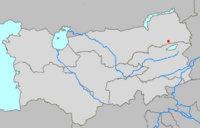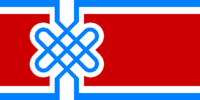Almalıq
| |||||||||
| City nickname: "Alma Atası" ("Father of Apples") | |||||||||
 Location of Almalıq in Turkestan | |||||||||
| Province | Qazaqstan | ||||||||
| Äkim | NAME OF LEADER | ||||||||
| Area | TOTAL AREA km² | ||||||||
| Population - Total (as of 2008) |
Almalıqıs 1,129,000 | ||||||||
| Time zone - summer (DST) |
Turkestan Time (UTC+ 6:00) Turkestan Summer Time (UTC+ 7:00) | ||||||||
Almalıq is one of the newer cities of Turkestan; it was founded during the first Russian occupation as the garrison town of Fort Verniy. After the liberation of Turkestan in the Basmaçı Revolt, Verniy was renamed after a small old Silk Road settlement called Almatu, which had stood near the site of Verniy until it was destroyed by the Russians. In a sense, Almalıq has been five separate cities built one after the other in the same place: the Silk Road town of Almatu, the Russian garrison city of Verniy, the Qurultaı period town of Almalıq, the EBÜK period Almalıq, and the modern city.
History
Early History and Fort Verniy
Almatu was a small trading settlement on the Silk Road, in the foothills of the Ala Tau mountains. It was neither important nor powerful.
During the first Russian invasion, Almatu was razed by the invaders, and a garrison established in the same valley and named Verniy ("Truthful"; "Reliable"). Verniy became one of the main centres of Russian rule in the Qazaq steppe and southwards into the rest of Turkestan. The town attracted a number of Russian settlers, and also a mixed bag of sarts and nomads.
In the final years of Russian rule, Verniy became the worst trouble-spot in the whole of Russian Turkestan. During the early Basmaçı Revolt, the rioting Turkestani nomads and sarts killed most of the area's Russian population, including the whole garrison, and set fire to the city.
Early Turkestan
Due to the city being effectively destroyed during the Basmaçı Revolt, Verniy/Almalıq went from a major garrison hub during the Russian occupation to a relatively minor town. Aq-Meşit was used as a de facto capital by the Qazaqs of the Little Horde, and Taraz by the Great Horde.
The EBÜK Period
Almalıq was one of the cities most extensively modernised by Jalan Quyrat-ulı. It was he, under Russian direction, that instituted the modern provincial administration, and it was he that decided to restore Almalıq to be a major city. Coinciding as this decision did with the beginning of the major modernisation of Turkestan, it gave Jalan Ilxan a great opportunity to effectively redesign the city in his own image.
Modern Almalıq
Since independence from snorist influence, Almalıq has been somewhat redesigned yet again. Many of Jalan Ilxan's Vissarionovist buildings had been destroyed by earthquakes, or had become critically damaged, and the new government was quite willing to invest in new building projects as "symbolic of a new era".
The city was bombed during the Qaşgar War, and among other buildings, the old Central Mosque was destroyed.
Map
- See Map of Almalıq for city street map.
Economy
Cultivation of apples is a traditional mainstay of the aymaq's economy. Apples were first cultivated in this region, and local diversity of varieties is immense. Many extended families or clans owning apple orchards typically focus on one or two varieties, some of which may be only cultivated by that family or clan.
Culture
Almalıq is probably the most modern and cosmopolitan of Turkestan's cities. Its modernity is in large part due to the fact that large parts of the old Tsarist settlement and preceding Silk Road town were destroyed in the early days of the Basmachi Revolt, and the city was not rebuilt very extensively until the 1950s. Thus, where other Turkestani cities such as Buxara and Ashgabat have a more ancient feel, Almalıq is an almost purely modern city. It is laid out largely on a grid pattern, though the very centre of the city around Ilxan Square and the Manesian High Temple is laid out in concentric rings. Other cities, by comparison, have streets following the traditional paths taken by livestock to water sources, or ploughmen to fields: far from straight, and confusing for all but a native.
Interestingly, the grid pattern seems to bewilder many Turkestanis, who are used to paths that wind around, and to finding their way by using the twists and turns as a series of landmarks in themselves. Non-natives of Almalıq are often complaining that they never know where they are; the local police are so used to having to stop and help bewildered Buxarans and Samarqandis find their way that many of them have taken to carrying a small stack of street maps on their person.
Almalıq is home to the chief Manesian temple in Turkestan, as well as having the almost obligatory Assyrian cathedral, Islamic mosque and Zoroastrian temples.
The city also boasts several large sporting facilities. The home grounds of the Almalıq Wolves kökbörü team in the northern district of Aynabulaq is the largest of its kind in the country, and to the south of the city in the Ala Tau mountains lies the Medeü-Şımbulaq winter sports complex.
Almalıq is well-known as the genetic home and first cultivation site of the apple tree, hence its nickname "Father of Apples". The city produces a stunning diversity of different varieties and cultivars, the most famous being the giant sweet "Aport" apple, which grows to a diameter of nearly 9". Several of the apple cultivars that are grown here are cultivated by as few as only one or two families, and many grow nowhere else in the world.
Tourist Destinations
- The Zodiac Fountain in Ilxan Square shows the twelve animals of the Central Asian 12-year animal cycle used in Turkestani calendars.
- The Manesian High Temple.
- The Ala Tau Mountains just to the south of the city.
- The Medeü-Şımbulaq Winter Sports Complex.
- Assyrian Cathedral of Mar Eprem.
- Russian Orthodox Cathedral of the Ascension, the only wooden building still surviving from the Tsarist era.
- Almalıq Central Mosque, recently rebuilt after its destruction during the Qaşgar War.






